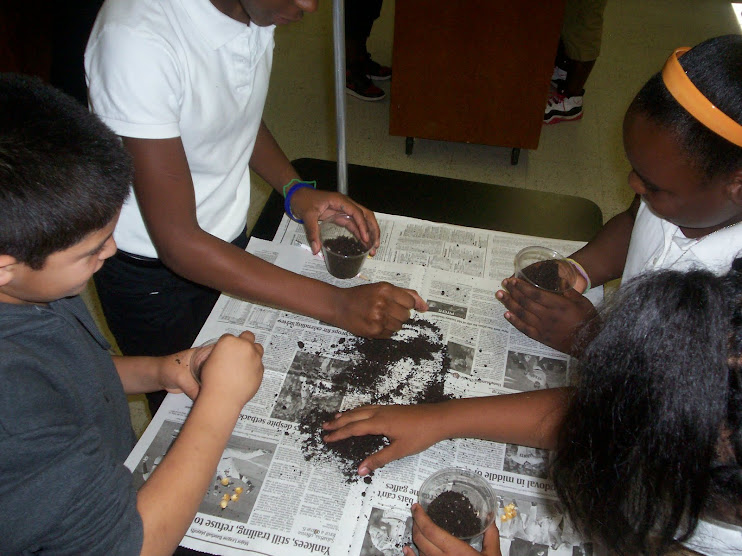• Facilitate Accountable Talk around “Communication”.
• Use small groups to differentiate reading and writing instruction.
• Guide students to identify cause-effect relationships and create graphic organizers to represent them.
• Monitor student fluency.
• Read aloud to students daily, choosing from both narrative and expository texts.
• Guide students to identify main idea and supporting details and create graphic organizers to represent them.
• Provide multiple exposures to unfamiliar terms, including word walls, personal dictionaries, and authentic writing tasks.
• Facilitate students’ use of prewriting strategies to select a topic and organize ideas for a persuasive composition.
• Guide students to design criteria charts for a persuasive composition.
• Scaffold students as they compose a persuasive composition.
• Confer with students throughout the writing process.
skip to main |
skip to sidebar


Wonderings began forming regarding rocky biome and seed germination.

Students begin to plant seedling in soil, sand, gravel, and pond water.

After read-aloud, students cast their plant growing predictions.

4th Grade students make predictions as to what they think will happen during the palnt cycle after reading "One Bean" by Anne Rockwell.

7th Grade Dallas ISD student has 4th Graders aid her investigation on plant growth in various conditions.

Dallas Educator, Ms. Lewis proudly sports her students efforts in creating projects about the different activities and places to visit in Mexico in honor of Cinco de Mayo.

5th Grade Bilingual students combine Reading and Math skills to construct bar graphs to depict researched information.

Line graph of female ESL student's improvements after repetitious phonemic lessons in Reading/Language Arts.

Bar graphs and line graphs depict evidence of students' growth during ESL Case Study after consistancy of differentiated, and phonemic awareness small group lessons.



After read-aloud, students conduct their own potting experience.


One student identifies the objective of Sequence from beginning, middle, to end.

Students in Plant Growth control group read One Bean by Anne Rockwell to build anticipation toward project.

Students in DallasISD celebrate Cinco De Mayo with class, style, and a smile.



Students gain knowledge of Science vocabulary word, "paleontologist." They look for shark teeth in hardend rock.


Case study groups use Bloom's Higher Order Thinking skills at the Environmental Research Center in Seagoville, TX. It is important to use all levels of students' modalities in order to increase a lesson's concepts.

Working with students in small groups during case study increased vocabulary concepts through building phonemic base. Here, students work on refining locating the right answer when reading. Apr. 2010


Students in Group D of case study brainstorm in pairs ways they can build a sentence using an interactive Literacy Chart. They must tell Who, Did What, When, and Where using Adj. that describe and Adv. that tell how.

Bravo! ESL student's confidence rises as she finally masters pulling out supporitng facts and writing them down. Three weeks ago, she was afraid to show her knowledge. Mar. 2010

ESL and Gen. Ed. students of case study use a bubble map to record facts & details that aid in memory retention of complex information. 3/11/10

ESL case study student practices Super Sentence Building by constructing a detailed paragraph. Feb.2010

Children's Books

Welcome to my weblog. I am excited about being a Teacher who uses interactive educational websites in the classroom, and in my personal business. Let this site serve as your resource for finding innovative ways in educating today's youth in this technological age.
Let the Experiment Begin!


Wonderings began forming regarding rocky biome and seed germination.

Students begin to plant seedling in soil, sand, gravel, and pond water.
7th Grade Dallas ISD Student's plant invetsigation peeks 4th Graders' interest!

After read-aloud, students cast their plant growing predictions.

4th Grade students make predictions as to what they think will happen during the palnt cycle after reading "One Bean" by Anne Rockwell.
Biomes: Can A Plant Germinate In Different Environments?

7th Grade Dallas ISD student has 4th Graders aid her investigation on plant growth in various conditions.
Educators Store For More-Become A Member
Lean on Me
Differentiated Instruction Aids Bilingual Students in Research

Dallas Educator, Ms. Lewis proudly sports her students efforts in creating projects about the different activities and places to visit in Mexico in honor of Cinco de Mayo.

5th Grade Bilingual students combine Reading and Math skills to construct bar graphs to depict researched information.
Final Synopsis of ESL Student Case Study

Line graph of female ESL student's improvements after repetitious phonemic lessons in Reading/Language Arts.

Bar graphs and line graphs depict evidence of students' growth during ESL Case Study after consistancy of differentiated, and phonemic awareness small group lessons.
Gotta Keep Reading
7th Grade Researcher Conducts Plant Growth Lab Experience



After read-aloud, students conduct their own potting experience.
Dallas ISD 7th Grader Leads 4th Grade Read-Aloud


One student identifies the objective of Sequence from beginning, middle, to end.

Students in Plant Growth control group read One Bean by Anne Rockwell to build anticipation toward project.
TeenBiz
Celebrating Cinco De Mayo

Students in DallasISD celebrate Cinco De Mayo with class, style, and a smile.


A Sharp Find!

Students gain knowledge of Science vocabulary word, "paleontologist." They look for shark teeth in hardend rock.

ESL Case Study Outing

Case study groups use Bloom's Higher Order Thinking skills at the Environmental Research Center in Seagoville, TX. It is important to use all levels of students' modalities in order to increase a lesson's concepts.
Multi-Sensory Teaching

Working with students in small groups during case study increased vocabulary concepts through building phonemic base. Here, students work on refining locating the right answer when reading. Apr. 2010

Build That Super Sentence!

Students in Group D of case study brainstorm in pairs ways they can build a sentence using an interactive Literacy Chart. They must tell Who, Did What, When, and Where using Adj. that describe and Adv. that tell how.
Look Who's Pulling It Out and Writing It Down!

Bravo! ESL student's confidence rises as she finally masters pulling out supporitng facts and writing them down. Three weeks ago, she was afraid to show her knowledge. Mar. 2010
Thinking Maps

ESL and Gen. Ed. students of case study use a bubble map to record facts & details that aid in memory retention of complex information. 3/11/10
Building Up To TAKS Writing

ESL case study student practices Super Sentence Building by constructing a detailed paragraph. Feb.2010
Pages
Internet4Classrooms
Mom's Homeroom
Literacy

Children's Books
Followers
About Me

- TSanders
- Dallas, Tx, United States
- Certified Texas State Educator for over 9 years in ESL/Gen Ed. for Grades 1-6th. *Graduate of Grambling State Univ. B.A.-Mass Comm. * Concordia Univ.; Masters of Education/Advanced Literacy
